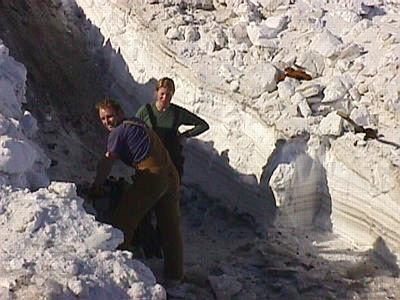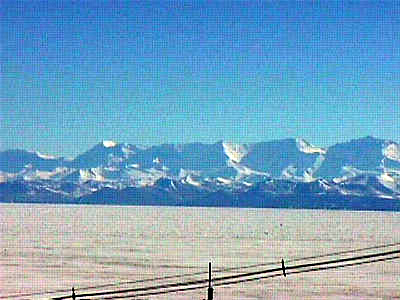18 November, 1998
Wednesday, November 18th, 1998
Hi everyone! Good news in our meeting this morning. They will be sending
people out to visit the drill site, now that the steering committee has just
about completed their visit. I am scheduled to go out on Friday night. They
send about 4 people at a time out to Cape Roberts by helicopter, and we will
stay for about 24 hours. During our visit we will stay at the Cape Roberts
camp…several temporary buildings. We will be flown to the drill site by
helicopter…only a short 6-7 minute ride. I have heard that we come back to
camp by Skidoo-hope that's true! We will get to see the drill process in
action, and learn how they analyze and describe the core just after it is
brought up and sliced in half. I am anxious to learn about this part of the
project.
Today's core went from 307.32 through 331.00 and the drill hole is currently
down to 412 meters. Things continue to go well at the drill site. They
expect to drill to about November 25th if the ice continues to be stable and
safe. They need to stop drilling in time for the downhole loggers to put
their instruments down the drill hole and make their measurements. I will be
talking about the downhole loggers later on .
Today's core was VERY different looking, compared to what we have been seeing.
It was thinly laminated sandstone and siltstone, with good sedimentary
structure. They haven't found a single fossil or trace fossil in this section
of core. The lithology (what the core if composed of and how those sediments
were deposited) of the core has changed significantly.
Again I labeled yesterday's samples and measured magnetic susceptibility.
Later Fabio and I drilled 38 new samples from today's core. This seems to be
our daily routine now. I am helping out a lot in the lab…and learning a lot
about geology, too. I am going to record Chris Fielding one of these
days…during his regular morning talks in the core sampling room, Chris gives
us the lithology and background on the core. He goes through each section and
gives details noted at the drill site, and by the sedimentologists here at
Crary Lab. The huge words he uses often confuse me, but I seem to know more
each day. I try to take notes and listen carefully so that I can learn as much
as possible.
I spent some time tonight helping Tom Ehnstrom, one of the welders, download
his digital photos from his camera to my laptop, and then later to a disk.
He's letting me use his photos of Antarctica along with my own. It's a
welcome addition of images…you will be seeing some of them today with this
journal.
Since I have time today, I'd like to tell you a little bit about another one
of the stations in Antarctica…South Pole Station. The existing facility was
completed in 1975. It replaced the original station which was built in
1956-57. The current technologies, related to power, water, fuel storage, and
communications are all inadequate to meet the modern needs of the station and
its inhabitants. The station was first built to accommodate 33 men in the
austral summer. It currently houses over 120 scientists and support personnel
and 80 people on the construction staff in the summer. 167 people are housed
in temporary surface buildings, which are nicknamed "Summer Camp." These are
insulated canvas and wood structures left over from the Korean War in 1950.
So, as you can see, there is a BIG need for a new South Pole Station. One is
currently under construction, and is scheduled to be completed by the year
2005. The new structure is elevated about 10 feet and can be raised to
accommodate the accumulation of snow. The new structure is modular and
panelized…everything must be transported to the South Pole by Hercules cargo
plane. The new station will house at least 110 people. It will use
alternative energy sources such as waste heat recovery and solar energy. This
new structure is the result of over 8 years of studies and planning.
Special considerations for building a new South Pole Station include:
1) The South Pole is only accessible during 4 months of the year. It is
accessible by airplane only.
2) Materials and supplies used to build this station have to be shipped by sea
from the United States to McMurdo Station, Antarctica. These materials and
supplies are then transported to South Pole Station.
3) The structures at the South Pole are built on the polar plateau…the
elevation is 9,450 feet above sea level. This is over two miles of ice that
shifts with the ice sheet at about 33 feet per year.
4) The average ambient temperature at the South Pole is -49 degrees F (-15
degrees C)
5) At the South Pole there is 6 months of daylight, 6 months of darkness.
6) If you are at the South Pole, you are about 838 miles from the nearest
person…McMurdo Station is FAR away.
7) Although is doesn't snow much at the South Pole (less than 1 foot per
year), the accumulated drifting and wind can be major concerns.
Well, I learned a lot…how about you? Today's photos have nothing to do with
the South Pole…I haven't been there to take any pictures. These are some
aerial views of McMurdo taken from Observation Hill by Tom Ehnstrom. It's
great because the day he hiked up there with friends, it had snowed. I will
try to find some South Pole pictures that I can send to you. Talk to you
tomorrow.
Betty :)

Oops! These are not Tom's photos...I couldn't open the files, so I'll try those another day The wonders of technology! This photo was taken today outside of Crary Lab. Workers were digging a path to clear snow away from some pipes. It gives you an idea of how deep the snow is in some areas of McMurdo. Many of the "streets" are very muddy right now. Other areas still have quite a bit of snow!

How would you like a view like this just outside of town? I left the power lines in the photo to give you some perspective. These are the Trans Antarctic Mountain s. I will fly over these mountains on my way to Cape Roberts.
Contact the TEA in the field at
.
If you cannot connect through your browser, copy the
TEA's e-mail address in the "To:" line of
your favorite e-mail package.
|
